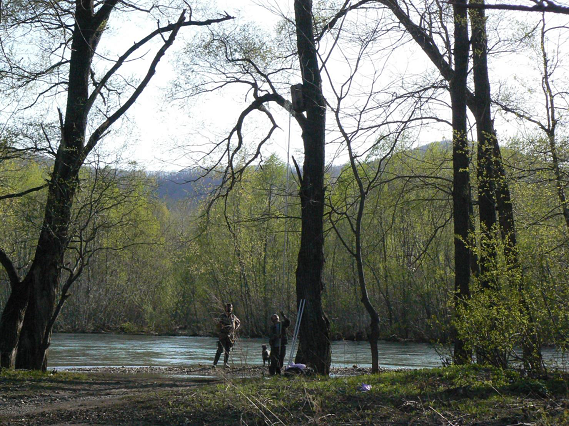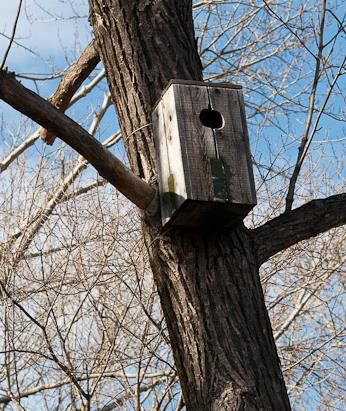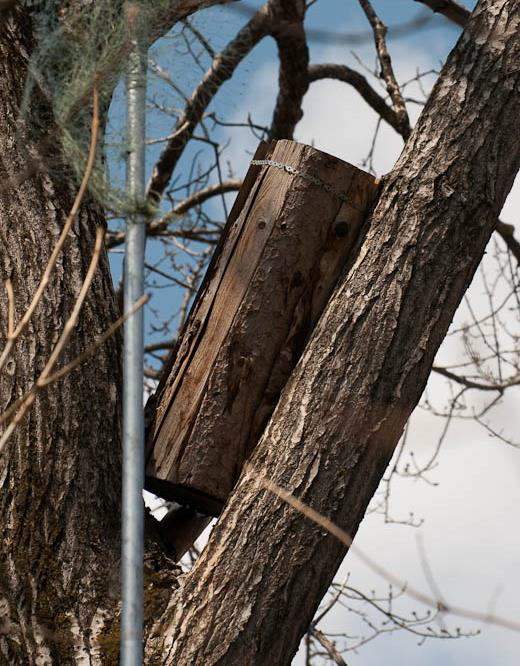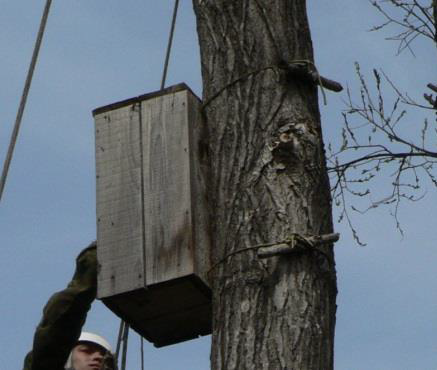General notes
Scaly-sided Merganser is extreme cavity nester. From the other hand the species inhabits only fast flowing clean rivers of third to seven order. Upper 40 km of river is not in use by this duck. Occurrence on flood-plain ponds and small creeks is irregular. Artificial nest site [ANS] occupation depends on forest quality on river banks. On the rivers with logged forest occupation of ANS is significantly higher than on un-logged rivers (Solovyeva et al 2013). Thus artificial nest program at un-logged habitats is useless.
Directions to ANS set up
Selection of the site
Scaly-sided Merganser pair has some sort of territoriality and territorial behavior. Our capture-recaptures shows even males are staying within 1-10 km from the nest site during pre-breeding and early breeding. Pairs are chasing each other from the territory. When placing of ANSs the distance between nearest nests should be ranged between 1 and 4 km along the river. This gives a better chance the ANSs are distributed on the territories of several pairs. Ideally the survey is needed to understand between pair distance on the given river. Even on the rivers of high density the distance was about 2 km.
According to our observations a merganser female checks large trees for nesting cavity. Small trees are not attractive to the female. The solitary large (> 15 m high, >0.7 m in diameter) tree on the river bank is the best for ANS placing. A group of large trees is second preferred. Small trees (solitary or group) are the less preferable for ANS. Tree species didn’t play any role in our study.
Distance to water was a factor of ANS occupation. Birds avoid ANS placed on trees close than 6 m to the water. The best distance is 10 to 40 m for solitary tree and 6 to 20 m for the group of trees on the river bank. ANS entrance should face a river in any case. Birds are seeking for cavity during flight along the river, they should see an entrance overfying the river. There shouldn’t be any small trees and bushes between ANS and river; in the case of presence they should be cut. Entrance should have open access from the river. Any branches which cover a view to the entrance should be cut (branches of ANS tree or other trees nearby). Most of females enter the cavity by jumping from the water, so the entrance should be open from the water.
Ground under the ANS entrance should be clean meadow. Merganser female avoid occupation of nest site with dense bush or dead logs under the entrance. There should be clean wide pass from the tree to the water for ducklings to leave a nest safely.
ANS height was a factor for occupation. We found ANS 12-13 m high were the best occupied (height of entrance above ground). Surprisingly ANS 6-7 m high were second preferable with occupation rate dropping down in ANS between 8 and 11 m.

Almost ideal position of ANS: in a group of large trees; 6 m from water; entrance faced a river; no lower branches; open access from the water; clean pass to the water. Height isn’t the best (9 m).
In Russia we select trees with no branches under the ANS for ANS to be inaccessible to humans. This might not be a case in other countries with better human reaction to wildlife. In the case of lower branches we cut them.
Selecting a tree you should remember a necessity to clean ANS prior to reproduction and to check ANS for the occupation and for the nest fate. So, from the one hand it should be easy accessible by car (100-400 m from car trail to the river) and from the other hand there should be less chance of potential disturbance by humans. We used boat transportation along the river to reach good forest patches for ANS, but these ANS are less possible for cleaning. Usual cleaning take place in March when rivers are ice covered and there is no access to ANS situated far from car trails. Boat should be used again to check these ANS (no problem when river is open).
Cleaning of the site
When cup branches, small trees or bushes you should always paint a fresh cut with dark (brown or grey) color. Birds are afraid of fresh cut (white surfaces). Remove all dead logs and fallen large branches between ANS and river.
Types of ANS
Two types of ANS were used by Scaly-sided merganser. They are tubes and boxes of goldeneye type (Fig. 2). Construction of tube is given in Solovyeva et al (2013) in details. This paper is available on the journal website or at http://www.eaaflyway.net/our-activities/task-forces/scaly-sided-merganser/
Erection of nest tube
Tube should have an angle of ideally 45o (range 40 to 70 o) to horizontal line. Large branch facing a river with this angle should be selected for tube. Tube is fixed with 100 and 200 mm metal nails on the bottom and on the top. Large branches were left un-touched (Figure 2 right) and smaller branches were cut to get a clean view to the tube entrance. We avoid cutting of large branch because of possibility of tree death after. However the branch often closed a view to entrance and it made female catching difficult.
Erection of nest box
It is always good to have one branch left in 20-50 cm under the box for operator to stay on (Figure 2 left). This branch should face aside to the entrance and doesn’t close a view. Box should be vertical or has slightly negative angle of front board for ducklings to get out easy. We fix a box with two 6 mm nylon ropes around the trunk (one rope close to the top and another close to the bottom of box). Ropes allow tree to grow in following years. Each rope is tied and then rolled with wooden stick (20 mm in diameter and 115-20 cm long)
References
Solovyeva, D.V., Vartanayan, S.L., & N. I-F. Vartanayan. 2013. Artificial nest-sites for Scaly-sided Merganser Mergus squamatus (Gould, 1864) – a way to breeding habitat restoration. Amurian zoological journal V(2): 201-207.
Download the full article (English Version)
Download the full article (Chinese Version)
Download the full article (Russian Version)







